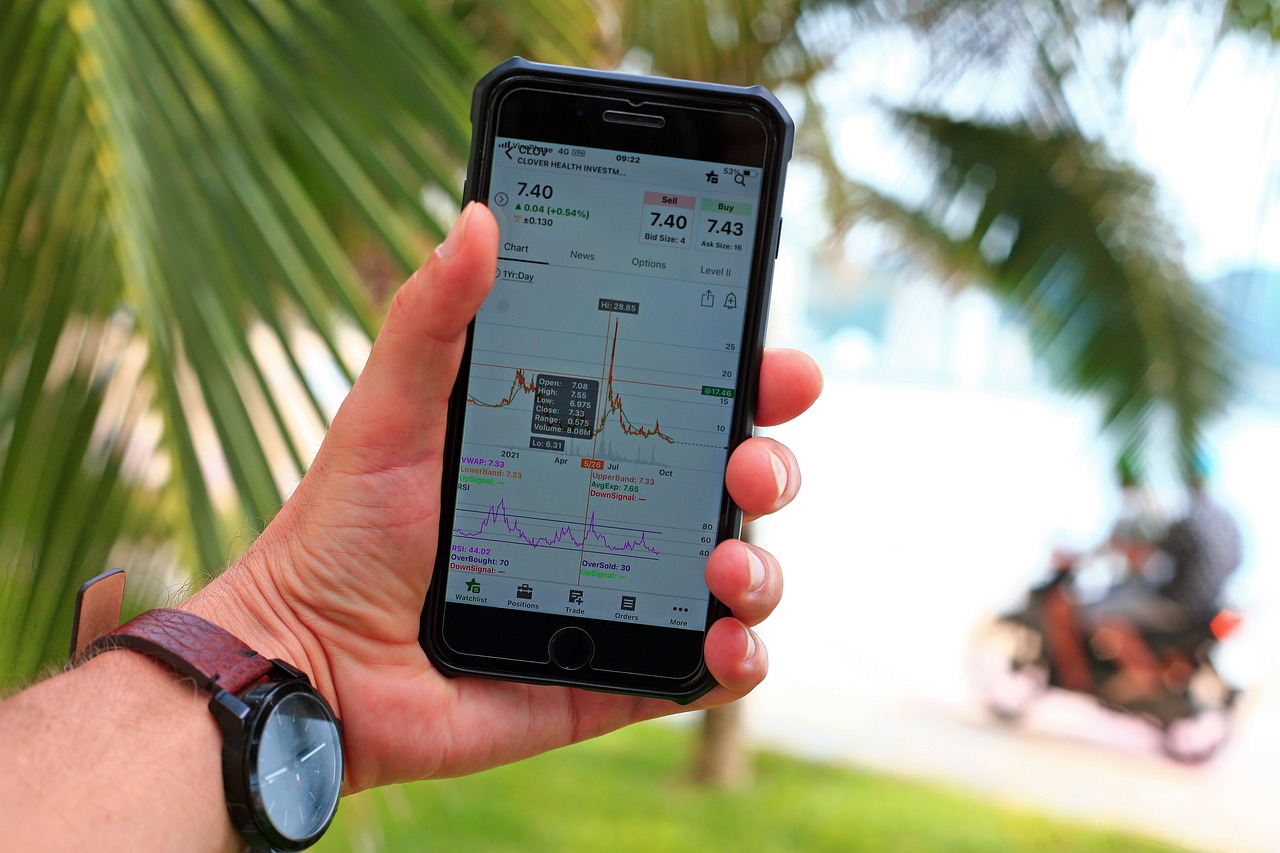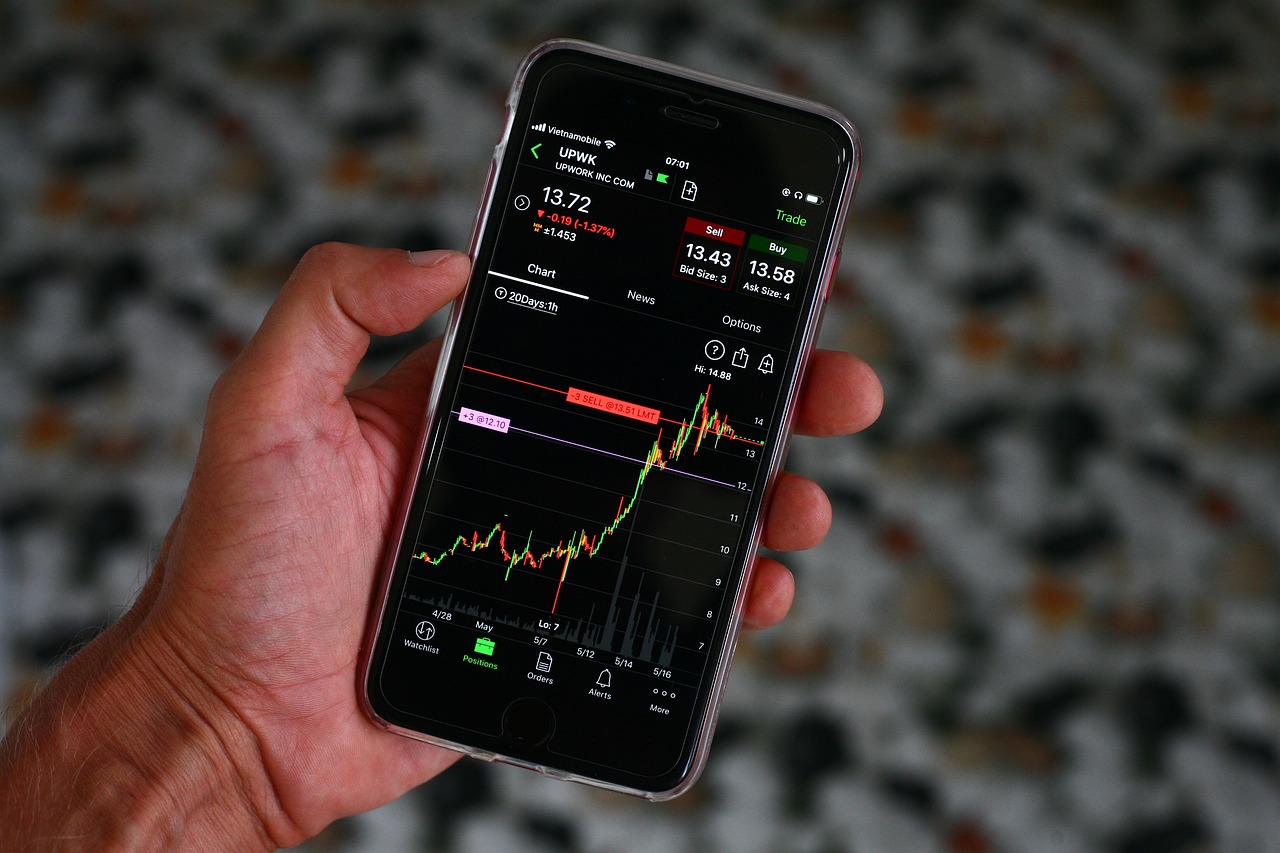Using Volatility as a Trading Strategy
In the world of trading, understanding and leveraging volatility can be the difference between a successful trade and a costly mistake. But what exactly is volatility? Think of it as the heartbeat of the market—sometimes racing, sometimes slowing down. It's the measure of how much the price of a security fluctuates over time, and it can provide traders with valuable insights into potential price movements. By harnessing this concept, traders can enhance their strategies and make more informed decisions.
Volatility is not just a random occurrence; it is influenced by various factors including economic indicators, market sentiment, and geopolitical events. When traders recognize these influences, they can anticipate market movements more effectively. This anticipation is crucial because it allows traders to position themselves advantageously, whether they are looking to ride the waves of price changes or hedge against potential losses. The beauty of trading with volatility lies in its potential for profit, but it also requires a keen understanding of risk management.
One of the most exciting aspects of trading volatility is the numerous strategies that can be employed. From options trading strategies like straddles and strangles to more complex approaches like volatility arbitrage, traders have a wealth of tools at their disposal. Each of these strategies allows traders to capitalize on the unpredictable nature of the markets, turning potential chaos into opportunity. However, it's important to approach these strategies with a clear plan and a solid understanding of the risks involved.
As we dive deeper into the world of volatility trading, we'll explore the types of volatility, how to calculate and apply historical volatility, and the implications of implied volatility. By the end of this article, you'll have a comprehensive understanding of how to use volatility as a powerful trading strategy. So, buckle up, because the journey through the ups and downs of the market is just beginning!
- What is market volatility?
Market volatility refers to the degree of variation in trading prices over a certain period. It indicates how much the price of a security can change. - How can I use historical volatility in my trading?
Historical volatility helps traders identify past price movements, allowing for better risk management and strategy formulation. - What are straddles and strangles?
These are options trading strategies that involve buying both call and put options to profit from significant price movements. - What is volatility arbitrage?
Volatility arbitrage is a strategy that exploits discrepancies between implied and historical volatility to identify trading opportunities. - How important is risk management when trading volatility?
Effective risk management is crucial in volatile markets to mitigate potential losses and enhance overall trading performance.

Understanding Market Volatility
This article explores the concept of volatility in trading, its significance, and how traders can leverage it to enhance their strategies and improve decision-making in the financial markets.
Market volatility refers to the degree of variation in trading prices over time. Imagine a roller coaster ride; the ups and downs symbolize the fluctuations in market prices. Just like that ride, the financial markets can be thrilling yet unpredictable. Understanding the causes of these price swings is crucial for traders, as it allows them to anticipate market movements effectively. Factors contributing to market volatility include economic news, earnings reports, geopolitical events, and changes in market sentiment. When these elements collide, they can create a perfect storm of price fluctuations, making it essential for traders to stay informed.
Moreover, recognizing volatility can significantly influence trading decisions. It’s not just about reacting to price changes; it’s about understanding the why behind those changes. For instance, when a company announces unexpected earnings, the stock price might skyrocket or plummet, reflecting the market's reaction to new information. Traders who grasp the nuances of volatility can position themselves to take advantage of these movements, increasing their chances of success.
To further illustrate, consider the following table that outlines key factors affecting market volatility:
| Factor | Description |
|---|---|
| Economic Indicators | Reports such as GDP growth, unemployment rates, and inflation can influence investor sentiment. |
| Earnings Reports | Company performance announcements can lead to significant price changes in stocks. |
| Geopolitical Events | Political instability or international conflicts can create uncertainty in the markets. |
| Market Sentiment | The overall mood of investors, whether optimistic or pessimistic, can drive volatility. |
In summary, understanding market volatility is akin to reading the pulse of the financial markets. It gives traders an edge, allowing them to make informed decisions based on the current landscape. By recognizing the factors that contribute to volatility, traders can better anticipate price movements and refine their strategies accordingly. So, the next time you hear about market fluctuations, remember that behind every swing lies an opportunity waiting to be seized!
There are two primary types of volatility: historical and implied. Each type provides different insights into market behavior and can influence trading strategies based on expected future price movements.
Historical volatility measures past price fluctuations of a security. Analyzing historical data helps traders identify trends and potential future movements, allowing for better risk management and strategy formulation.
Calculating historical volatility involves statistical methods that quantify price changes over a specific period, offering traders a clearer picture of past market behavior and potential future risks.
Traders can use historical volatility to set stop-loss orders, determine position sizing, and identify entry and exit points, ultimately enhancing their trading strategies and risk management.
Implied volatility reflects the market's expectations of future price movements. It is a crucial component in options pricing and can signal market sentiment, helping traders make strategic decisions.
Traders can implement various strategies to capitalize on volatility, including straddles, strangles, and volatility arbitrage. These strategies aim to profit from price fluctuations while managing risk effectively.
Straddles and strangles are options strategies that involve buying calls and puts to profit from significant price movements. Understanding their mechanics can help traders maximize returns during volatile market conditions.
Volatility arbitrage involves exploiting discrepancies between implied and historical volatility. This strategy requires keen analytical skills and market knowledge to identify opportunities and manage associated risks effectively.
Effective risk management is essential when trading in volatile markets. Implementing strategies such as diversification and position sizing can help mitigate potential losses and enhance overall trading performance.
Setting stop-loss orders is a vital risk management technique that helps limit losses during unpredictable price movements. Traders should strategically place these orders based on their risk tolerance and market conditions.
Diversification involves spreading investments across various assets to reduce risk. In volatile markets, this approach can cushion against significant losses and enhance the stability of a trader's portfolio.
1. What is market volatility?
Market volatility is the degree of variation in trading prices over time, indicating how much a market price fluctuates.
2. How can I measure historical volatility?
Historical volatility can be measured using statistical methods that analyze past price changes of a security over a specific time frame.
3. What is implied volatility?
Implied volatility reflects the market's expectations of future price movements, often used in options pricing.
4. What are some strategies for trading volatility?
Common strategies for trading volatility include straddles, strangles, and volatility arbitrage, each designed to profit from price fluctuations.
5. How can I manage risk in volatile markets?
Risk can be managed through techniques like setting stop-loss orders, position sizing, and diversification across various assets.

Types of Volatility
When diving into the world of trading, understanding the is paramount. Volatility isn't just a buzzword; it's a crucial indicator that can shape your trading strategies. Broadly speaking, there are two primary types of volatility: historical volatility and implied volatility. Each type serves a distinct purpose and provides unique insights into market behavior, which can significantly influence your trading decisions.
Historical volatility is all about the past. It measures the degree of price fluctuations of a security over a specific timeframe. Think of it as looking in the rearview mirror while driving; it helps you understand where you've been, which can inform where you might be headed. Traders analyze historical volatility to identify patterns and trends that can signal potential future movements. For instance, if a stock has shown significant price swings in the past, it might indicate a propensity for the same in the future, making it a candidate for closer monitoring.
On the flip side, we have implied volatility, which is more about the future. It reflects the market's expectations regarding future price movements and is a key component in options pricing. Implied volatility can be thought of as the market's collective mood; when traders expect significant price changes, implied volatility tends to rise, indicating heightened uncertainty or anticipation. Conversely, when the market is calm, implied volatility usually decreases. This type of volatility can be a goldmine for traders looking to gauge market sentiment and make strategic decisions based on anticipated price fluctuations.
To illustrate the differences between historical and implied volatility, consider the following table:
| Type of Volatility | Description | Purpose in Trading |
|---|---|---|
| Historical Volatility | Measures past price fluctuations over a specific timeframe. | Helps identify trends and manage risk based on historical data. |
| Implied Volatility | Reflects market expectations of future price movements. | Indicates market sentiment and assists in options pricing. |
Understanding these two types of volatility can provide traders with a comprehensive toolkit for navigating the financial markets. By leveraging both historical and implied volatility, traders can enhance their decision-making processes, optimize their strategies, and ultimately improve their chances of success. So, whether you’re a seasoned trader or just starting, keeping an eye on these volatility types can be your secret weapon in the ever-changing world of finance.
- What is the main difference between historical and implied volatility? Historical volatility looks at past price movements, while implied volatility reflects market expectations for future movements.
- How can I use volatility in my trading strategy? Traders can analyze historical volatility to identify trends and use implied volatility to gauge market sentiment, both of which can inform entry and exit points.
- Is high volatility always a good thing for traders? Not necessarily. While high volatility can present opportunities for profit, it also increases risk. It's essential to manage risk effectively when trading in volatile markets.

Historical Volatility
When we talk about , we're diving into the realm of past price fluctuations of a security. Think of it as a time machine that allows traders to look back at how a stock or asset has behaved over a specific period. This analysis is crucial because it helps traders identify patterns and trends that might repeat themselves in the future. Just like how a weather forecast is based on previous weather patterns, traders rely on historical data to anticipate market movements.
To put it simply, historical volatility is a measure of how much the price of a security has varied over a given timeframe. If a stock has experienced wild price swings in the past, it’s considered to have high historical volatility. Conversely, if its price has remained relatively stable, it’s seen as having low volatility. This information is not just for show; it plays a pivotal role in shaping trading strategies. By analyzing historical volatility, traders can make informed decisions about when to enter or exit positions, set stop-loss orders, and manage their overall risk.
Calculating historical volatility involves using statistical methods to quantify these price changes. Traders often look at a specific time frame, such as 30 days, and gather the closing prices of the asset. From there, they can calculate the standard deviation of those price changes, which gives them a clearer picture of how volatile the asset has been. Here’s a simplified formula for historical volatility:
Historical Volatility Standard Deviation of Price Changes x √(Number of Trading Days in a Year)
This formula helps traders understand the risk associated with an asset and can be a game-changer in their trading approach. For instance, if a trader notices that a stock has a historical volatility of 20%, they might decide to adjust their position size accordingly or set tighter stop-loss orders to protect against potential losses.
Moreover, the applications of historical volatility extend beyond just entering and exiting trades. It can also guide traders in setting up their risk management strategies. Here are a few ways traders utilize historical volatility:
- Setting Stop-Loss Orders: By understanding how much a stock typically fluctuates, traders can place stop-loss orders at strategic levels that account for normal price movements without being prematurely triggered.
- Position Sizing: Traders can determine how much capital to allocate to a trade based on the asset's volatility. Higher volatility often means smaller position sizes to mitigate risk.
- Identifying Entry and Exit Points: Historical volatility can help traders spot potential reversal points or breakout opportunities based on past price behavior.
In conclusion, historical volatility is more than just a number; it's a powerful tool that can enhance a trader's strategy and decision-making process. By understanding how an asset has moved in the past, traders can better navigate the unpredictable waters of the financial markets. Remember, in trading, knowledge is power, and knowing the historical volatility of your assets is a critical part of that knowledge.

Calculating Historical Volatility
Calculating historical volatility is a crucial skill for traders who want to understand the past price movements of a security. It involves using statistical methods to quantify how much the price of an asset has fluctuated over a specific time frame, typically expressed as a percentage. This percentage gives traders a clearer picture of how volatile an asset has been, allowing them to make more informed decisions about future trades.
One of the most common methods to calculate historical volatility is to use the standard deviation of the asset's returns. The formula can seem daunting at first, but it essentially measures how spread out the returns are from their average. Here’s a simplified version of the process:
1. Gather historical price data for the security. 2. Calculate the daily returns by finding the percentage change in price from one day to the next. 3. Compute the average of those daily returns. 4. Subtract the average return from each daily return to find the deviation. 5. Square each deviation. 6. Calculate the average of those squared deviations. 7. Take the square root of that average to find the standard deviation. 8. Finally, multiply the standard deviation by the square root of the number of trading days in a year (usually 252) to annualize the volatility.
This calculation provides a valuable insight into how much risk is associated with a particular security. For example, if a stock has a historical volatility of 20%, it means that, on average, the price of the stock can be expected to fluctuate by 20% over the course of a year. This information can be incredibly useful for traders when assessing the potential risks and rewards of a trade.
Moreover, understanding historical volatility can help traders set appropriate stop-loss orders and determine the size of their positions. For instance, if a trader is aware that a stock typically experiences high volatility, they may choose to reduce their position size to manage risk more effectively. Conversely, if they find a stock with low historical volatility, they might feel more comfortable taking on a larger position.
In summary, calculating historical volatility is not just about crunching numbers; it's about gaining a deeper understanding of market behavior and making strategic decisions based on that knowledge. By mastering this calculation, traders can enhance their risk management strategies and improve their overall trading performance.
- What is historical volatility? Historical volatility measures how much the price of a security has fluctuated over a specific period in the past.
- Why is historical volatility important? It helps traders assess the risk associated with an asset and make informed trading decisions.
- How often should I calculate historical volatility? Traders often calculate it regularly, especially when analyzing new trades or adjusting existing positions.
- Can historical volatility predict future price movements? While it provides insights, historical volatility cannot guarantee future price behavior; it merely reflects past trends.

Applications of Historical Volatility
This article explores the concept of volatility in trading, its significance, and how traders can leverage it to enhance their strategies and improve decision-making in the financial markets.
Market volatility refers to the degree of variation in trading prices over time. Understanding its causes and implications can help traders make informed decisions and anticipate market movements effectively.
There are two primary types of volatility: historical and implied. Each type provides different insights into market behavior and can influence trading strategies based on expected future price movements.
Historical volatility measures past price fluctuations of a security. Analyzing historical data helps traders identify trends and potential future movements, allowing for better risk management and strategy formulation.
Calculating historical volatility involves statistical methods that quantify price changes over a specific period, offering traders a clearer picture of past market behavior and potential future risks.
Traders can leverage historical volatility in several impactful ways, enhancing their trading strategies and improving decision-making. One of the primary applications is in setting stop-loss orders. By understanding how much a security has fluctuated in the past, traders can set their stop-loss orders at levels that minimize potential losses while allowing for normal price movements.
Another significant application is in determining position sizing. Traders can use historical volatility to gauge how much of a particular asset to buy or sell. For instance, if a stock has a high historical volatility, a trader might decide to take a smaller position to mitigate risk. Conversely, if the volatility is low, a larger position might be justified.
Furthermore, historical volatility can be instrumental in identifying entry and exit points. By analyzing past price movements, traders can spot patterns that indicate optimal times to enter or exit a trade. This is particularly useful during periods of market uncertainty when price swings can be more pronounced.
To summarize, here are some key applications of historical volatility:
- Setting Stop-Loss Orders: Helps in limiting losses during unpredictable price movements.
- Determining Position Sizing: Aids in deciding the amount to invest based on risk tolerance.
- Identifying Entry and Exit Points: Facilitates strategic trading decisions based on past trends.
Implied volatility reflects the market's expectations of future price movements. It is a crucial component in options pricing and can signal market sentiment, helping traders make strategic decisions.
Traders can implement various strategies to capitalize on volatility, including straddles, strangles, and volatility arbitrage. These strategies aim to profit from price fluctuations while managing risk effectively.
Straddles and strangles are options strategies that involve buying calls and puts to profit from significant price movements. Understanding their mechanics can help traders maximize returns during volatile market conditions.
Volatility arbitrage involves exploiting discrepancies between implied and historical volatility. This strategy requires keen analytical skills and market knowledge to identify opportunities and manage associated risks effectively.
Effective risk management is essential when trading in volatile markets. Implementing strategies such as diversification and position sizing can help mitigate potential losses and enhance overall trading performance.
Setting stop-loss orders is a vital risk management technique that helps limit losses during unpredictable price movements. Traders should strategically place these orders based on their risk tolerance and market conditions.
Diversification involves spreading investments across various assets to reduce risk. In volatile markets, this approach can cushion against significant losses and enhance the stability of a trader's portfolio.
Q: What is market volatility?
A: Market volatility refers to the degree of variation in trading prices over time, indicating how much the price of a security fluctuates.
Q: How can I use historical volatility in my trading strategy?
A: Historical volatility can help you set stop-loss orders, determine position sizes, and identify optimal entry and exit points for trades.
Q: What is the difference between historical and implied volatility?
A: Historical volatility measures past price fluctuations, while implied volatility reflects market expectations of future price movements.
Q: Why is risk management important in volatile markets?
A: Effective risk management helps traders mitigate potential losses and protect their investments during unpredictable market conditions.

Implied Volatility
is a fascinating concept that reflects the market's expectations regarding future price movements of a security. Unlike historical volatility, which looks back at past price changes, implied volatility is all about what traders think will happen next. It plays a crucial role in the pricing of options and can significantly influence trading strategies. Think of it as the market's way of whispering its predictions about future uncertainty. When traders see high implied volatility, they often interpret it as a sign of potential price swings, which can either lead to exciting opportunities or risky pitfalls.
One of the most intriguing aspects of implied volatility is how it can signal market sentiment. For example, if implied volatility is rising, it may indicate that traders are expecting a significant event—like an earnings report or economic news—that could cause the stock price to move dramatically. Conversely, low implied volatility might suggest that traders are feeling relatively calm about the stock's price stability. This understanding can be a game changer for traders, as it allows them to gauge not just the potential for movement, but also the market's mood.
To put it simply, implied volatility can be viewed as a barometer of market sentiment. When traders are anxious, implied volatility tends to rise, indicating that they expect larger price swings. On the other hand, when traders are relaxed, implied volatility usually falls. This dynamic creates a valuable opportunity for traders who can read these signals accurately. By incorporating implied volatility into their trading strategies, they can better position themselves to capitalize on potential price movements.
Incorporating implied volatility into your trading strategy involves a few key considerations:
- Options Pricing: Implied volatility is a critical component of options pricing models, such as the Black-Scholes model. Higher implied volatility generally leads to higher option premiums, making it essential for traders to understand how it affects their trades.
- Market Conditions: Traders should always consider the broader market environment. High implied volatility might be a signal to adopt a more cautious approach, while low implied volatility could present opportunities for more aggressive strategies.
- Timing: Timing is everything in trading. Understanding when implied volatility is likely to rise or fall can help traders make informed decisions about when to enter or exit positions.
In summary, implied volatility is not just a number; it’s a window into the market’s collective mindset. By leveraging this information, traders can enhance their strategies and make more informed decisions. As with any trading strategy, it’s vital to combine this knowledge with solid risk management practices to navigate the unpredictable waters of the financial markets effectively.
Q: What is the difference between historical volatility and implied volatility?
A: Historical volatility measures past price fluctuations, while implied volatility reflects the market's expectations of future price movements. Historical volatility looks backward, whereas implied volatility looks forward.
Q: How can I use implied volatility in my trading strategy?
A: You can use implied volatility to gauge market sentiment, assess options pricing, and determine optimal entry and exit points for trades. It can help you anticipate price movements based on market expectations.
Q: Is high implied volatility always a good thing?
A: Not necessarily. While high implied volatility can indicate potential for larger price movements, it also comes with increased risk. Traders should carefully assess their risk tolerance and market conditions before making decisions.

Volatility Trading Strategies
Trading in volatile markets can feel like riding a roller coaster—exciting, but also a bit nerve-wracking! To turn that volatility into profit, traders can employ a variety of strategies that capitalize on price swings. By understanding and utilizing these strategies, traders can enhance their chances of success while managing their risk effectively. Let's dive into some popular volatility trading strategies that can help you navigate the ups and downs of the market.
One of the most well-known strategies is the straddle. This involves buying both a call option and a put option at the same strike price and expiration date. The idea is to profit from significant price movements in either direction. Imagine you're standing at the edge of a cliff, waiting for the wind to push you either way. If the market moves sharply up or down, your straddle can capture that momentum. However, keep in mind that this strategy can be costly due to the premiums paid for both options. Therefore, it's crucial to ensure that the potential price movement justifies the initial outlay.
Another strategy that traders often use is the strangle. Similar to a straddle, a strangle involves buying both a call and a put option, but at different strike prices. This strategy is generally less expensive than a straddle, as the options are out of the money. Picture it as having a safety net that is wider but perhaps a bit less secure. If the market moves significantly, you can still profit, but you need to account for the larger price movement required to break even. Understanding the dynamics of both straddles and strangles can be a game changer in volatile conditions.
Then there's volatility arbitrage, a more sophisticated strategy that seeks to exploit discrepancies between implied volatility and historical volatility. Traders who engage in volatility arbitrage look for instances where the market's expectation of future volatility (implied volatility) is misaligned with the actual past volatility of an asset. It's like being a detective in the financial world—analyzing clues to find hidden opportunities. This strategy requires a keen analytical mindset and a solid grasp of market behavior to identify when to enter and exit trades effectively.
To illustrate how these strategies can be applied, consider the following table that summarizes the key aspects of straddles, strangles, and volatility arbitrage:
| Strategy | Description | Risk Level | Cost |
|---|---|---|---|
| Straddle | Buying a call and a put at the same strike price | High | High (due to two premiums) |
| Strangle | Buying a call and a put at different strike prices | Medium | Lower than straddles |
| Volatility Arbitrage | Exploiting discrepancies between implied and historical volatility | Variable | Depends on market conditions |
While these strategies can be effective, they also come with their own set of risks. It's essential to have a solid understanding of the market and to implement robust risk management techniques. This might include setting stop-loss orders to protect your capital or diversifying your portfolio to spread your risk across different assets. Remember, in the world of trading, knowledge is power, and preparation is key!
- What is the best volatility trading strategy for beginners? For beginners, starting with strangles might be a good option due to their lower cost and flexibility.
- How do I know when to use a straddle or a strangle? Use a straddle when you anticipate a significant price movement but are unsure of the direction; opt for a strangle when you expect volatility but want to lower your initial investment.
- Can volatility trading strategies be used in all market conditions? While these strategies are designed for volatile markets, they can also be adapted for less volatile conditions with careful planning and analysis.

Straddles and Strangles
When it comes to navigating the unpredictable waters of the financial markets, straddles and strangles stand out as powerful options trading strategies. Both strategies are designed to capitalize on significant price movements, regardless of the direction in which the market swings. Think of them as your trusty compass and map when venturing into the wilderness of volatility. They can guide you through turbulent times and help you find profitable paths.
A straddle involves purchasing both a call option and a put option at the same strike price and expiration date. This approach is particularly useful when traders anticipate a big move but are unsure of which direction it will take. For instance, if a company is about to release its earnings report, traders might expect a sharp price movement but may not know if it will be a rise or a fall. By employing a straddle, they can profit from the volatility that follows the announcement. However, it's important to note that this strategy requires the underlying asset to move significantly enough to cover the cost of the options.
On the other hand, a strangle is similar but involves buying a call option and a put option with different strike prices, both set to expire on the same date. This strategy typically costs less than a straddle since the options are purchased out-of-the-money. Traders might opt for a strangle when they believe that the market will experience volatility but want to minimize their initial investment. The key to success with strangles is to ensure that the price movement exceeds the combined cost of the options purchased.
Both strategies come with their own sets of challenges and risks. Traders need to be aware of the following:
- Market Timing: The success of straddles and strangles heavily relies on timing. Entering too early or too late can significantly impact profitability.
- Cost Considerations: The cost of purchasing options can eat into potential profits. It's crucial to evaluate whether the anticipated price movement justifies the investment.
- Volatility Assessment: Understanding market volatility is essential. Traders should analyze historical data to gauge potential price fluctuations.
In summary, straddles and strangles are versatile strategies that can provide traders with opportunities to profit from market volatility. Whether you choose to go with a straddle for its straightforward approach or a strangle for its cost-effectiveness, the key is to remain vigilant and informed. Keep your eyes on the market trends, and you might just find that these strategies can help you navigate the choppy waters of trading with confidence.
Q: What is the main difference between a straddle and a strangle?
A: The primary difference lies in the strike prices. A straddle uses the same strike price for both the call and put options, while a strangle involves different strike prices for the call and put options.
Q: When should I use a straddle?
A: A straddle is best used when you expect a significant price movement but are uncertain about the direction. Events like earnings reports or major announcements can trigger such volatility.
Q: Are straddles and strangles suitable for all traders?
A: While these strategies can be beneficial, they may not be suitable for all traders. It's important to assess your risk tolerance and market knowledge before diving in.
Q: How do I manage the risks associated with these strategies?
A: Effective risk management techniques include setting stop-loss orders, diversifying your portfolio, and continuously monitoring market conditions.

Volatility Arbitrage
Volatility arbitrage is a fascinating trading strategy that seeks to capitalize on discrepancies between implied volatility (the market's forecast of future volatility) and historical volatility (the actual volatility observed in the past). This strategy essentially involves buying and selling options to profit from the differences in these volatility measures. But why is this important? Well, understanding these discrepancies can provide traders with lucrative opportunities to enhance their returns while managing risk effectively.
To grasp the concept of volatility arbitrage, it's crucial to recognize that the market often misprices options based on its expectations for future volatility. For instance, if the implied volatility of an option is significantly higher than the historical volatility of the underlying asset, a trader might consider selling that option, expecting the price to adjust downward as the market corrects itself. Conversely, if the implied volatility is lower than historical volatility, buying the option could be a smart move, anticipating a rise in its value as market conditions change.
One of the key aspects of successful volatility arbitrage is the ability to analyze and interpret market data accurately. Traders need to be equipped with robust analytical skills and a deep understanding of the underlying assets. This requires not only technical analysis but also a keen awareness of market sentiment and macroeconomic factors that can influence volatility. For example, during earnings announcements or major economic reports, implied volatility often spikes, creating potential arbitrage opportunities.
Let’s break down the process of volatility arbitrage into a few essential steps:
- Identify Opportunities: Look for discrepancies between implied and historical volatility using analytical tools and charts.
- Execute Trades: Buy or sell options based on your analysis, ensuring to manage your risk appropriately.
- Monitor Positions: Keep a close eye on market movements and adjust your positions as necessary to lock in profits or mitigate losses.
Despite its potential for profit, volatility arbitrage is not without its risks. Market conditions can change rapidly, and unexpected events can lead to significant losses. Therefore, effective risk management is paramount. Traders should consider employing strategies such as setting stop-loss orders and diversifying their portfolios to cushion against adverse movements. Moreover, staying informed about market news and economic indicators is vital, as these can greatly influence volatility and, consequently, the success of arbitrage strategies.
In conclusion, volatility arbitrage offers a unique avenue for traders to exploit market inefficiencies. By understanding the dynamics between implied and historical volatility, traders can make informed decisions that not only enhance their potential for profit but also help in managing risks effectively. As with any trading strategy, continuous learning and adaptation to market changes are essential for long-term success.
- What is volatility arbitrage? Volatility arbitrage is a trading strategy that seeks to profit from discrepancies between implied and historical volatility in the options market.
- How do I identify volatility arbitrage opportunities? Traders can identify opportunities by analyzing charts and data that compare implied volatility to historical volatility, looking for significant discrepancies.
- What risks are associated with volatility arbitrage? Risks include rapid market changes, unexpected events affecting volatility, and potential losses if the market does not correct as anticipated.
- Is volatility arbitrage suitable for all traders? While it can be profitable, volatility arbitrage requires a solid understanding of market dynamics and risk management, making it more suitable for experienced traders.

Risk Management in Volatile Markets
When it comes to trading in volatile markets, risk management is not just a good idea; it’s a necessity. Imagine you’re on a roller coaster, with its thrilling ups and downs. Without a safety harness, the ride can quickly turn into a nightmare. Similarly, in trading, especially during periods of high volatility, having a solid risk management strategy is your safety harness. It keeps you secure, helps you navigate the unpredictable twists and turns, and ensures you don’t fall off the track.
One of the most effective ways to manage risk is through the use of stop-loss orders. These are like your safety nets, automatically selling your asset when it reaches a certain price. By setting these orders, you can limit your losses during sudden market downturns. However, it’s crucial to place these orders strategically. If you set them too tight, you might get stopped out during normal market fluctuations. On the other hand, setting them too loose might expose you to larger losses. Balancing this is key to effective trading.
Another important aspect of risk management is diversification. Think of your investment portfolio as a fruit basket. If you only have apples and a sudden blight affects apple trees, your entire basket is at risk. However, if you include a variety of fruits—bananas, oranges, and grapes—you cushion yourself against losses. In volatile markets, diversifying your investments across different asset classes can significantly reduce risk. This strategy not only helps to stabilize your portfolio but also opens up opportunities for gains from different sectors.
To illustrate how diversification works, consider the following table:
| Asset Class | Risk Level | Potential Return |
|---|---|---|
| Stocks | High | High |
| Bonds | Low | Moderate |
| Real Estate | Moderate | Moderate to High |
| Commodities | High | High |
As you can see, each asset class has its own risk and return profile. By spreading your investments across these different classes, you can potentially enhance your returns while minimizing risk. This is particularly important in volatile markets where any one asset can swing dramatically.
Furthermore, regularly reviewing and adjusting your risk management strategies is crucial. The market is constantly changing, and what worked yesterday might not work today. Keeping an eye on your investments and being ready to adapt your strategies is essential for long-term success. This means not only monitoring your stop-loss orders and diversification but also staying informed about market conditions and economic indicators that could affect your assets.
In conclusion, managing risk in volatile markets is akin to navigating through a stormy sea. With the right tools and strategies—like stop-loss orders and diversification—you can keep your ship afloat and even find new opportunities amidst the waves. It’s all about being prepared, staying informed, and knowing when to adjust your sails. So, buckle up and get ready to ride the waves of the market with confidence!
- What is a stop-loss order? A stop-loss order is an instruction to sell a security when it reaches a certain price, helping to limit potential losses.
- How can diversification help in risk management? Diversification spreads investments across various asset classes, reducing the impact of poor performance in any single investment.
- Why is it important to review risk management strategies regularly? The market is dynamic, and regular reviews help ensure that your strategies remain effective in changing conditions.
- What role does market volatility play in trading strategies? Market volatility can present both risks and opportunities; understanding it allows traders to capitalize on price movements while managing potential losses.

Setting Stop-Loss Orders
Setting stop-loss orders is one of the most crucial techniques in a trader's toolkit, especially in the unpredictable landscape of volatile markets. Imagine you're sailing on a boat in choppy waters; without a life jacket, you're at the mercy of the waves. Similarly, in trading, a stop-loss order acts as your safety net, protecting you from significant losses when the market takes an unexpected turn. By pre-defining the maximum amount you're willing to lose on a trade, you can maintain your composure and avoid emotional decision-making during those turbulent times.
So, how do you determine where to set your stop-loss orders? It's essential to consider several factors:
- Market Conditions: Analyze the current market environment. Are we experiencing high volatility? If so, you might want to set your stop-loss a bit further away from the current price to avoid being triggered by normal price fluctuations.
- Technical Analysis: Utilize chart patterns and technical indicators. For example, placing your stop-loss below a significant support level can provide a buffer against market noise.
- Risk Tolerance: Know your risk appetite. If you're more risk-averse, you might prefer tighter stop-loss orders, while aggressive traders might opt for wider ones to capture larger price movements.
Moreover, it's not just about where to set your stop-loss; the type of stop-loss order you choose also matters. There are several types:
| Type of Stop-Loss | Description |
|---|---|
| Fixed Stop-Loss | A predetermined price level set when entering a trade, regardless of market conditions. |
| Trailing Stop-Loss | This adjusts automatically as the price moves in your favor, locking in profits while still providing downside protection. |
| Percentage Stop-Loss | Set at a specific percentage away from the entry price, allowing for a more dynamic approach based on market volatility. |
Ultimately, the goal of setting a stop-loss order is to manage risk effectively. By doing so, you can focus on executing your trading strategy without the constant worry of losing more than you're willing to bear. Just like a seasoned captain knows when to adjust the sails, a savvy trader understands when and how to set their stop-loss orders. This proactive approach not only improves your trading discipline but also enhances your overall performance in the financial markets.
- What is a stop-loss order? A stop-loss order is an instruction to sell a security when it reaches a certain price, helping to limit potential losses.
- How do I decide where to set my stop-loss? Consider market conditions, technical analysis, and your personal risk tolerance when determining your stop-loss level.
- Can I adjust my stop-loss after placing it? Yes, you can modify your stop-loss order at any time, depending on your trading strategy and market conditions.

Diversification Strategies
Diversification is like having a safety net in the unpredictable circus of trading. Imagine walking a tightrope—if you only have one rope to balance on, a gust of wind could send you tumbling down. However, if you have multiple ropes, each supporting you in different ways, you're more likely to stay upright even when the winds of volatility blow. In the financial markets, diversification means spreading your investments across various assets to reduce risk and enhance potential returns.
The essence of diversification lies in the idea that not all investments will move in the same direction at the same time. By holding a mix of asset classes—such as stocks, bonds, commodities, and real estate—you can cushion your portfolio against the shocks that come from market fluctuations. For instance, when stock prices are plummeting, bonds might be performing well, helping to offset losses. This approach not only stabilizes your returns but also allows you to capitalize on different market conditions.
To effectively implement a diversification strategy, consider the following key elements:
- Asset Classes: Invest across different asset classes. Stocks, bonds, real estate, and commodities can react differently to market events.
- Geographic Diversification: Don't limit your investments to one country or region. Global markets can provide opportunities and reduce risk.
- Sector Diversification: Within stocks, diversify across various sectors like technology, healthcare, and consumer goods. This way, if one sector underperforms, others may thrive.
Moreover, diversification isn't just about the number of assets you hold; it's also about the correlation between them. Ideally, you want to combine assets that do not move in tandem. For example, if you invest in both tech stocks and gold, they might react differently to economic changes—tech stocks may soar during a market boom, while gold often shines during downturns. This strategy can create a more resilient portfolio that can weather various market conditions.
It's also essential to continuously review and adjust your diversification strategy. As market conditions change, some assets may become more correlated than before, reducing the effectiveness of your diversification. Regularly assessing your portfolio ensures that you maintain a balance that aligns with your risk tolerance and investment goals.
In conclusion, diversification is a crucial strategy for any trader looking to navigate the choppy waters of volatility. By spreading your investments wisely and keeping an eye on market dynamics, you can enhance your trading performance and minimize potential losses. Remember, just like a well-prepared tightrope walker, a diversified portfolio can help you maintain your balance even when the unexpected occurs.
1. What is diversification in trading?
Diversification in trading refers to the practice of spreading investments across various financial instruments, asset classes, or markets to reduce risk and enhance potential returns.
2. Why is diversification important?
Diversification is important because it helps mitigate risks associated with market volatility. By investing in different assets, you can cushion against significant losses if one investment performs poorly.
3. How can I diversify my portfolio?
You can diversify your portfolio by investing in a mix of asset classes (stocks, bonds, real estate), across different sectors (technology, healthcare), and geographic locations (domestic and international markets).
4. Is there a limit to how much I should diversify?
While diversification is beneficial, over-diversification can dilute potential returns. It's essential to find a balance that aligns with your investment goals and risk tolerance.
Frequently Asked Questions
- What is market volatility?
Market volatility refers to the degree of variation in trading prices over time. It indicates how much the price of a security fluctuates, and understanding this concept can help traders anticipate market movements and make informed decisions.
- What are the two main types of volatility?
The two primary types of volatility are historical volatility and implied volatility. Historical volatility measures past price fluctuations, while implied volatility reflects the market's expectations of future price movements.
- How is historical volatility calculated?
Historical volatility is calculated using statistical methods that quantify price changes over a specific period. This calculation provides traders with a clearer picture of past market behavior, which can inform future trading strategies.
- How can traders use historical volatility in their strategies?
Traders can utilize historical volatility to set stop-loss orders, determine position sizing, and identify entry and exit points. By analyzing past price movements, they enhance their risk management and overall trading strategies.
- What is implied volatility and why is it important?
Implied volatility indicates the market's expectations of future price movements and is crucial in options pricing. It can signal market sentiment, helping traders make strategic decisions based on potential future volatility.
- What are straddles and strangles?
Straddles and strangles are options strategies that involve buying both call and put options to profit from significant price movements. Understanding these strategies can help traders maximize returns during volatile market conditions.
- What is volatility arbitrage?
Volatility arbitrage is a strategy that exploits discrepancies between implied and historical volatility. It requires strong analytical skills and market knowledge to identify opportunities while effectively managing risks.
- How can traders manage risk in volatile markets?
Effective risk management in volatile markets involves strategies such as diversification and position sizing. These techniques help mitigate potential losses and enhance overall trading performance.
- What are stop-loss orders and why are they important?
Stop-loss orders are essential risk management tools that limit losses during unpredictable price movements. Traders should place these orders strategically based on their risk tolerance and current market conditions.
- What is diversification and how does it help in volatile markets?
Diversification involves spreading investments across various assets to reduce risk. In volatile markets, this strategy helps cushion against significant losses and enhances the stability of a trader's portfolio.



















